For more than a year, the world has been battling SARS-CoV-2 and the economic impact of this great pandemic. While there is an enormous amount of work left to do across the globe, countries leading the COVID-19 exit have given us a glimpse of how hearts and minds can shift to reunions with friends and family, and a return to more normal work and life. As we emerge, what is the right paradigm to guide our collective effort of transitioning through the end of the pandemic to a better future for all?
In March 2020, we suggested that the imperatives of our time were the battles needed to flatten two curves: the curve of the viral spread and the curve of the economic shock. Today, after two terrible peaks of viral spread, and with the vaccine rollout progressing, some regions are finally close to flattening both curves (Exhibit 1). Many others have seen three or even four peaks; their situation remains difficult, and in some countries is as bad as it has ever been. Even some countries that flattened their curves early are again at risk, as new variants spread and vaccination rates are low. The battle is far from over.
Of course, governments have applied public-health measures and economic stimulus with varying intensity, and experienced different impacts on mortality and their economies. But one thing is now clear. In early 2020, there was a debate on the trade-off between the virus and the economy. At that time, we suggested that the question was off the mark: there was no trade-off. The facts are now clear: as this article will show, no country kept its economy moving well without also taking control over the virus spread.
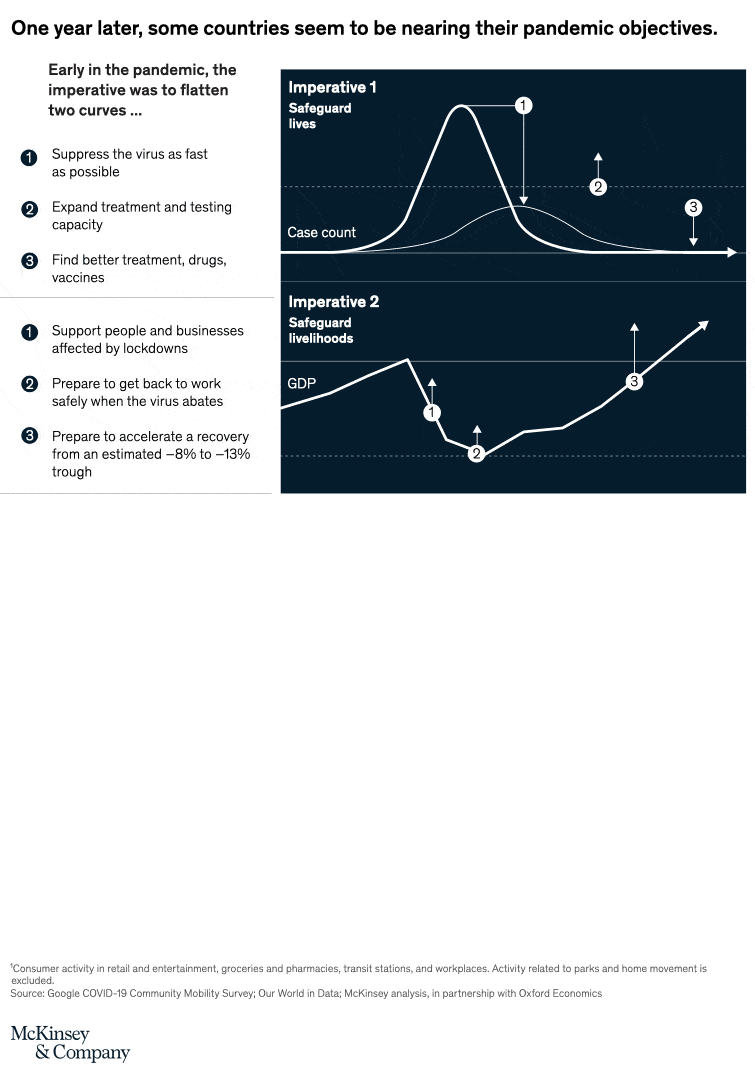
The big question now is what should public- and private-sector leaders focus on next? Is the agenda still about how we deliver on the twin imperatives of safeguarding lives and livelihoods? We think so. But what do the twin imperatives mean when we translate them into the current reality and the possibilities for the next decade? Three broad beliefs shape our answers.
- First, 3 to 4 percent global economic growth is achievable with available technology—a “productivity miracle” is not needed.
- Second, we do not have to choose between sustained and inclusive growth—quite the opposite, these goals can be complementary. Past periods of sustained growth have shown across countries and over time that “a rising tide” is a tried and true way to “lift all boats.”1
- Third, the medical advances and process accelerations achieved in response to this pandemic open the possibility that we spark a renaissance in public-health innovation and delivery and make rapid and unprecedented progress tackling persistent health problems.
If global leaders set the expectations that these outcomes are possible, and act on them, then the world could be on the cusp of a new age of prosperity: an economic recovery that will add 30 to 50 percent to GDP over the next decade, with better quality of life for more people, and a more sustainable future for the planet. If not, then the recovery could end up adding only 10 to 20 percent to GDP, less equitably distributed, less sustainable, and with worse outcomes for global health and the environment.
It’s an extraordinary opportunity—and a commensurate challenge. The road ahead will be rough in places. The first year of the pandemic and the policies designed in response have had a profound impact on how people regard their governments, on how well economies are positioned to rebound from the crisis, and how much public and private debt has been accumulated through weathering the economic disruption. However, provided the world’s public- and private-sector leaders make the right moves, a new age of prosperity for all could become a reality.
Reality check: The costs of the pandemic
One year on, how did the world fare in containing the spread of the virus, and in cushioning the economic impact it had on people everywhere? As Exhibit 1 shows, despite early optimism, even OECD countries experienced at least two peaks of COVID-19 cases and related deaths, and economic activity is not yet fully back.
While OECD countries managed to cap the exponential spread of the virus, they weren’t able to crush it. Depending on the effectiveness of their response, countries and regions wound up with distinctly different economic outcomes (Exhibit 2). No country grew its economy while also suffering high mortality. The best economies are found in countries with the lowest mortality and the most economic stimulus.
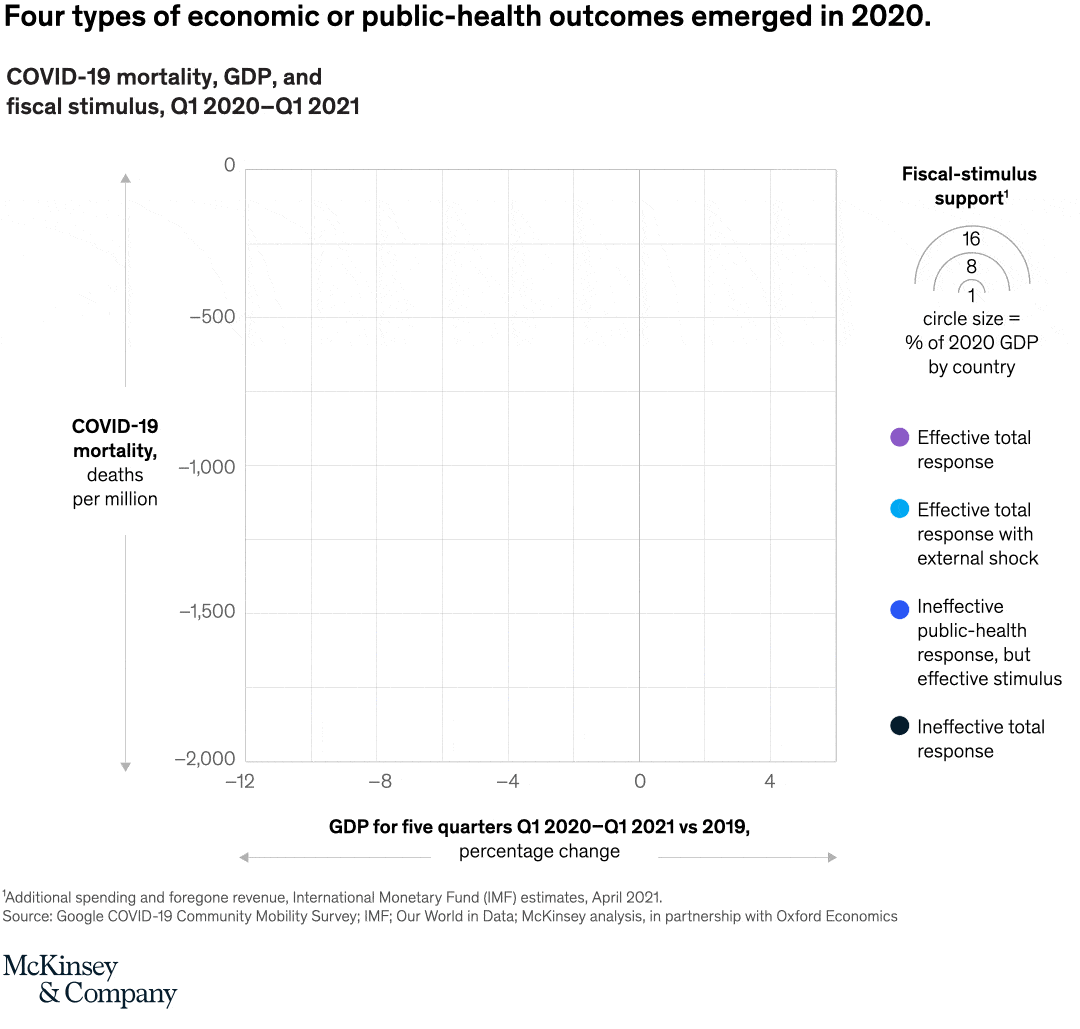
Many factors played a role in shaping the outcomes of the pandemic, including how early the outbreak happened, the readiness to respond, the need for lockdowns, as well as the degree of economic support provided to the economy through fiscal and monetary interventions. Initial conditions also mattered—the underlying health and age of populations as well as the momentum of economies prior to the pandemic.
Countries and regions that controlled the virus, and those that supported their economies the most, fared better. A few that were well prepared and had the means to act swiftly weathered the crisis best. The often-mentioned trade-off between the virus and the economy did not materialize (for more on these outcomes, see the sidebar “Four pandemic outcomes”).
What can we learn from the events of 2020? While there are many lessons, the overriding insight is that acting with determination and speed mattered most. That’s true for protecting lives from the virus, and for the vigor required to protect livelihoods from the subsequent economic shock. The faster governments moved, and the greater the scale of the intervention, the better outcomes for citizens were. How we convert these learnings to better manage future pandemics will undoubtedly be the subject of many debates.
A crossroads for lives and livelihoods?
Fortunately—and this was by no means a given—COVID-19 vaccines were developed in record time, and they work. In early 2021, real-world data from Israel and the United Kingdom validated the clinical-trial results by showing a sharp reduction in hospitalizations and deaths. Other countries are now experiencing similar results. The vaccines also appear to be effective in reducing transmission and against the variants of concern encountered thus far. Furthermore, the global vaccine rollout has made real strides in scaling production and setting up supply chains to support massive inoculation programs that are now accelerating in many countries. Just as important: sentiment about vaccine adoption is improving.
To be sure, there have been setbacks, and risks abound; the formation of new virus mutations is of particular concern. Endemicity is almost certain in various parts of the world, most likely in places where vaccine access is limited, where few people choose to be vaccinated, or where virus variants reduce vaccine efficacy. Endemicity might include cyclic, seasonal waves of disease, broadly like the flu, or even a multiyear cycle of resurgence. But on balance, safe, effective vaccines are changing the game. We are witnessing one of the true miracles of modern science.
On the economic front, government support through fiscal and monetary policies has also unequivocally worked. Employment is recovering in all countries, though at different rates. As a result, uncertainty is receding and losing the paralyzing grip it took in the early part of the pandemic (Exhibit 3).
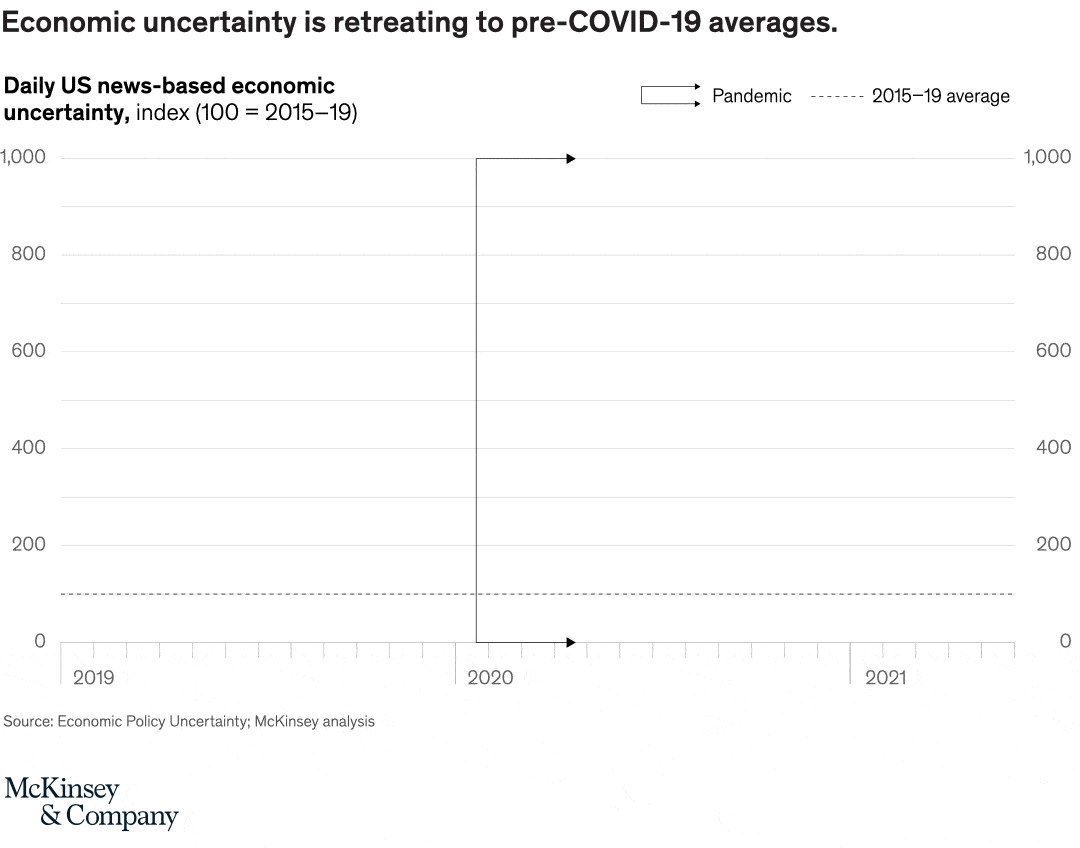
There now is a keen sense that the world is moving steadily to the next stage of the pandemic. Progress on reducing the virus spread differs depending on where you live. But it seems that in some countries, such as the United States and the United Kingdom, the transitional return to normal is under way. Herd immunity in some regions might be reached well before the end of 2021. Most of Europe is on a similar path, though on a slightly slower timetable.
The outlook for economic progress is also brightening for countries leading the COVID-19 exit, with positive results now being reported for Q1. But the virus still dictates the economy—Japan, which has experienced a recent resurgence and a set of lockdowns, reported negative growth in Q1. Even some countries that have yet to fully reopen and are currently facing challenges are likely to see strong headline GDP growth in 2021 in the scenarios that will most likely bound the outcomes during the next two years (Exhibit 4). (For more on our scenarios, see sidebar “Nine scenarios for COVID-19.”)

The real question is not so much about whether and when economies around the world will exit from the disruptive crisis—they will—but whether the exit will be strong enough to reinvigorate widespread growth in jobs and income and avoid a return of inflation or debilitating burdens from increased debt.
Are we heading for a 20 percent or 40 percent economic expansion?
Not all businesses, industries and economies face the same circumstances today and will certainly fare differently in the years ahead. But some fundamental questions that will affect almost everyone are now emerging with more clarity:
- Will the pace of economic growth return to its pre-COVID-19 path, even if the composition of the next-normal economy turns out to be different?
- Will the pandemic have lasting negative impact on growth, for entire economies and specific sectors in particular?
- Is it possible that the pandemic will have a galvanizing positive impact on growth and productivity in the global economy?
History suggests that there are essentially two types of economic expansions after recession: those that see GDP grow by 10 to 20 percent cumulatively in postcrisis years, and those that see 30 to 50 percent cumulative growth (Exhibit 5).
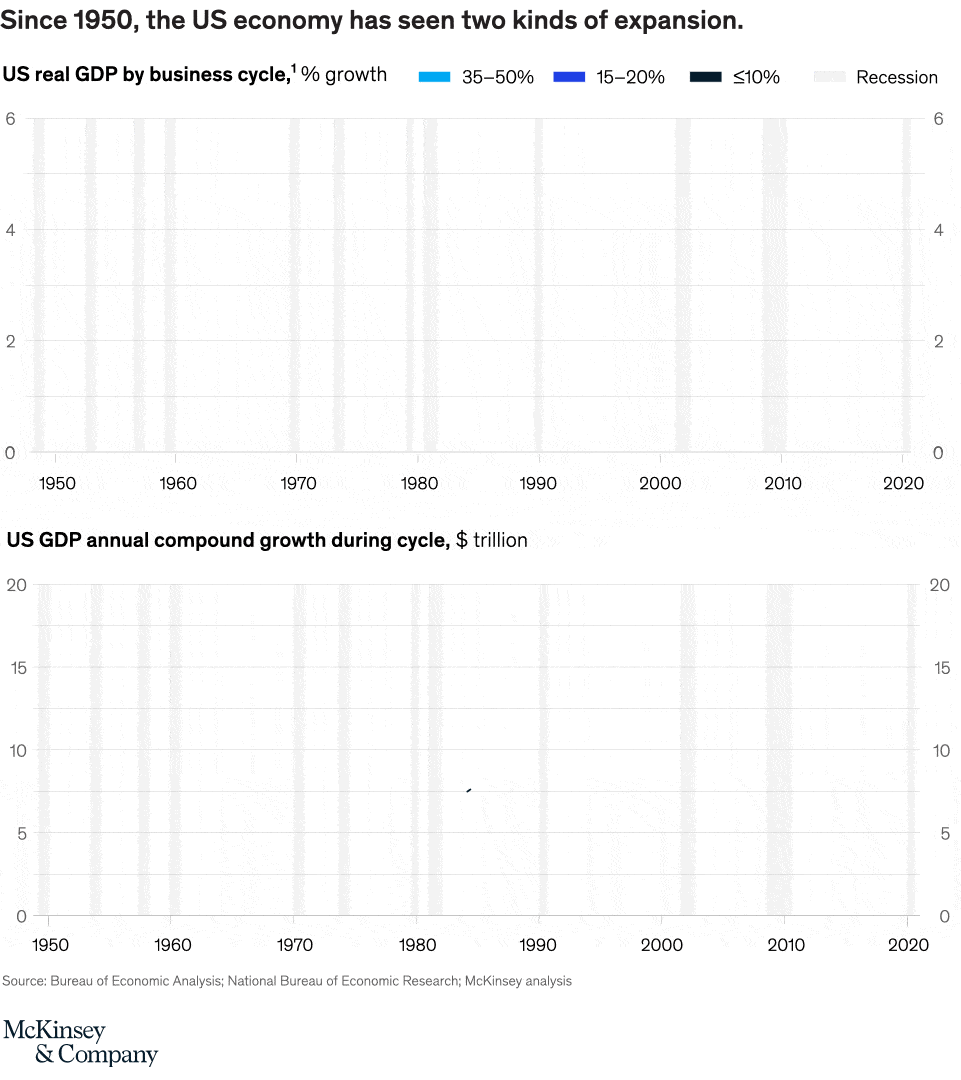
In the United States, the expansions in the 1960s, 1980s, and 1990s all delivered cumulative increases of total GDP of 30 to 50 percent. Call them “40 percent recoveries.”2 Other countries performed similarly during some or all of these periods including Australia, Canada, Singapore, South Korea, and the United Kingdom. All were aided by some combination of demographic tailwinds, higher investment, and productivity surges, underpinned by supportive economic and business policies.
Other US recoveries, like those in the 1970s, 2000s, and 2010s, have delivered only half that growth. The tepid pace of recovery coming out of the financial crisis was not limited to the United States; GDP in France and Germany did not return to 2008 levels for three to four years, the United Kingdom took five years, Spain nearly nine years, and Italy’s GDP was still 5 percent below its 2008 level when the pandemic hit in 2020.
Forty percent recoveries do not happen by accident. They are the result of choices made by leaders in government and business and by individuals, families, and households.
Regression to pre-COVID-19 limitations
A 40 percent recovery is by no means guaranteed. Any near-term spending surge could easily prove temporary, returning the global economy to a 2 to 3 percent growth trajectory, mirroring our worst performance over the past decade. In this case, growth would be constrained in new and old ways:
- Vaccination campaigns avert the worst outcomes, but COVID-19 becomes endemic in most countries, causing cyclic, seasonal waves of disease.
- Productivity gains from accelerated digitalization trigger layoffs to save costs, not new opportunities for job creation. The transition toward sustainability is halting.
- Labor-market tensions persist, driven by skill mismatches, rising unemployment (especially among the young), and stagnant wages. Social tensions over the distribution of a limited and shrinking set of resources remain a polarizing force.
- Innovation slows to “below COVID-19 speed,”—the rapid pace of progress defined by vaccine development—thus limiting advances in health and technology.
Millions of workers have dropped out of the labor force. Some industries have been left with significant and persistent overcapacity. The rise of the digital economy could suppress investments in physical assets as companies capitalize on productivity gains. The global economy could be stuck in a mediocre growth trajectory. But a 20 percent recovery is also not preordained.
The possibility of a new age of prosperity for all
Imagine a recovery that delivers 3 to 4 percent sustained global GDP growth over at least a decade. Such a recovery starts with a well-managed exit from the pandemic that masters the tricky hand off from demand led by government stimulus to private-sector-led spending, income, and job creation. If we make good choices, it might look like this:
- Increasing vaccination rates drive uncertainty even lower and unleash the large cache of accumulated savings and pent-up demand to engage in “real life” again.
- Accelerated digitization and important transitions toward sustainability trigger new demand, new jobs, and higher productivity growth.
- Significant reskilling and smart assistance to vulnerable populations support a broad-based recovery in workforce participation, human capital, and wages. The economy becomes more inclusive.
- Better public health and lower mortality rates become the norm as many positive new behaviors from the COVID-19 crisis are incorporated into everyday lives (better hygiene, more concern for the health of others, faster and more decisive reactions to public-health threats).
- Medical innovation accelerates, for example by bringing mRNA-related and other cures to major diseases like cancer and malaria (a new malaria vaccine has reported promising data from its Phase 2 trial).
Our analysis shows that in a new age of prosperity for all, global growth reaches 3.6 percent annually by 2030, nearly 1.5 percentage points above the “limitations” scenario at that time (Exhibit 6). It’s a seemingly small difference, but from acorns grow mighty oaks. Momentum builds as businesses invest and create jobs in response to rising demand and the need to catch up on postponed upgrades to equipment, structures, and training. About 30 percent of net new growth comes from investment and another 20 percent from more people working with better skills. This kind of recovery is sustained by the higher living standards of households and profits of businesses that stronger productivity, which accounts for the remaining 50 percent of growth, delivers.3
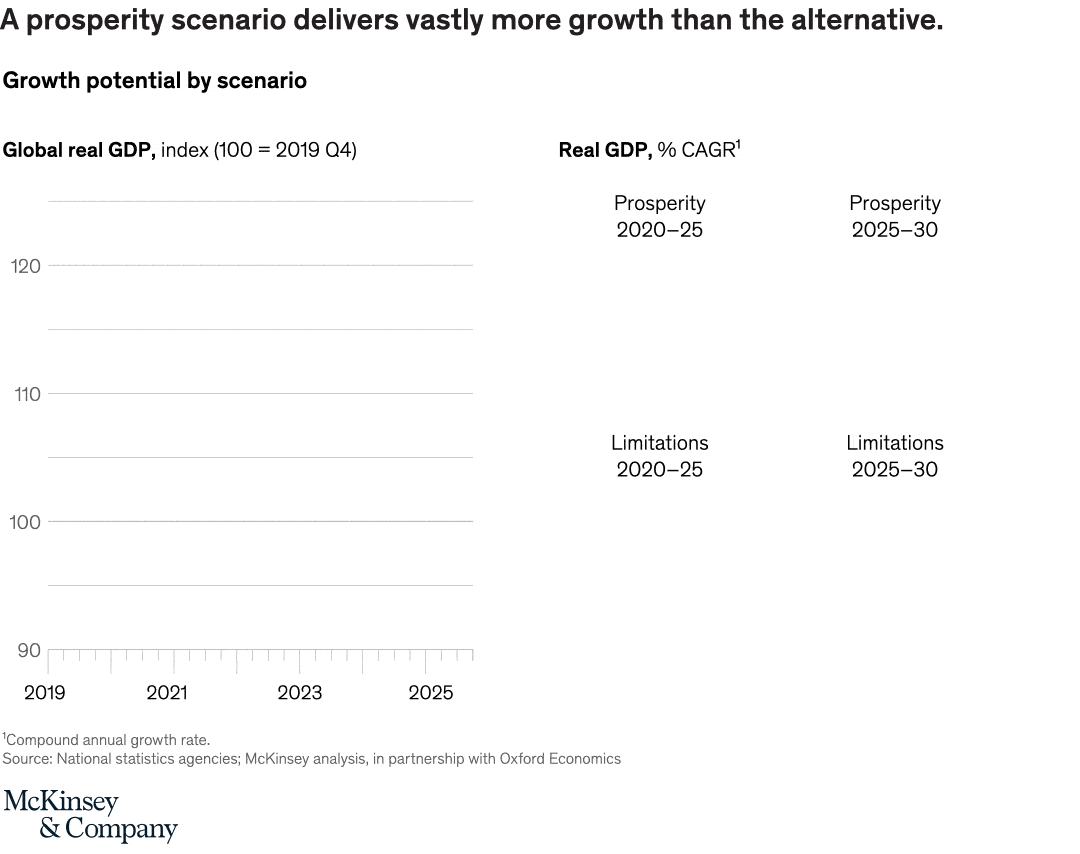
Concerns about debt and inflation
To deliver on a new age of prosperity for all, the global economy will have to deal with two concerns raised as part of the debate about “going for growth”: first, that newly accumulated debt will become unsustainable and constrain growth, and, second, that there is a potential for higher inflation. Both are a possibility—but both can also be dispatched.
Problems from a debt overhang are not inevitable. In the United States, for example, outstanding debt in 2020 reached 133 percent of GDP, topping the previous record of 123 percent in 1946, just after World War II. But in the post-war years, and in many other examples over time, the debt burden was reduced by driving nominal growth, not by cutting debt (Exhibit 7).4
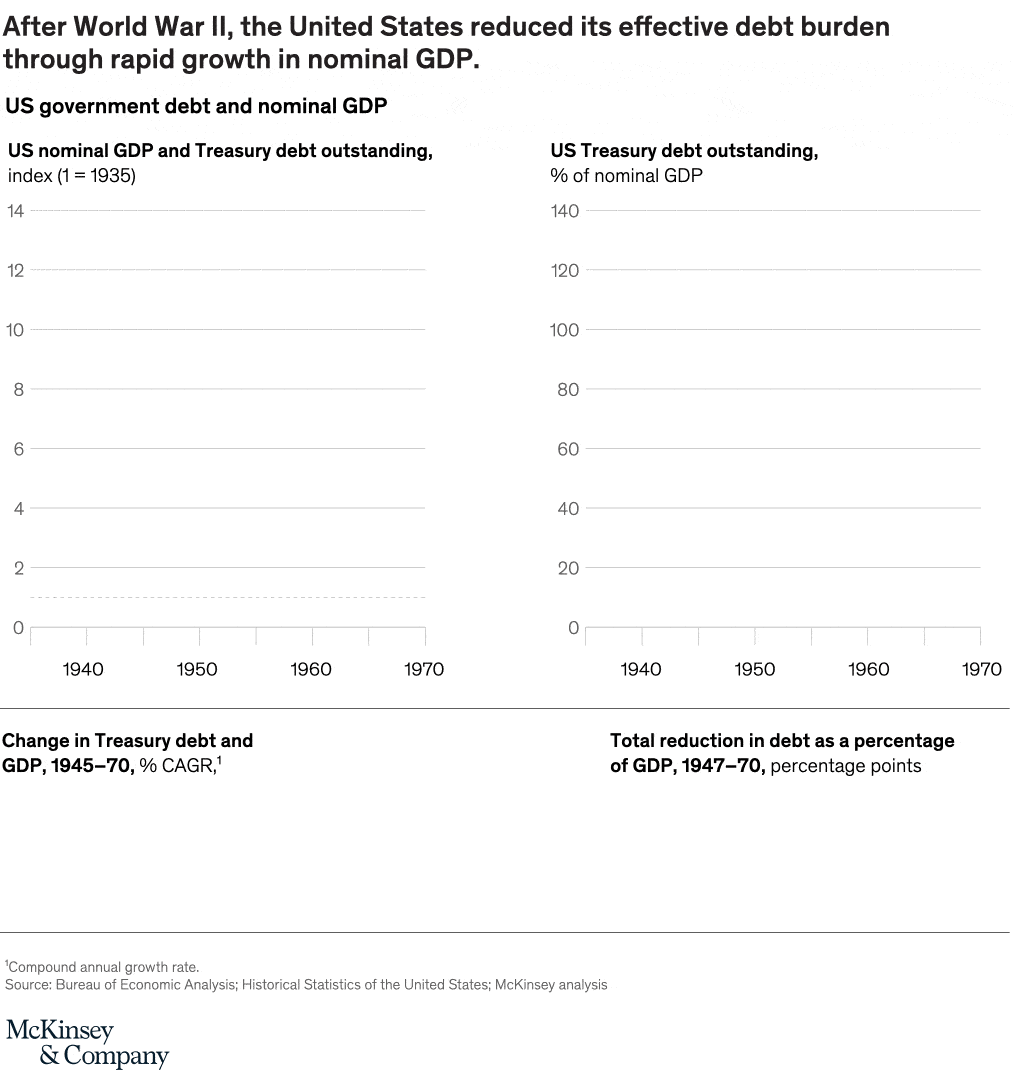
Similarly, in a new age of prosperity for all, the debt burden could again fall, as nominal GDP growth exceeds debt growth and the nominal interest rate (Exhibit 8).

The second issue is inflation. The stimulus pumped into the system by fiscal authorities and central banks is creating a snapback in spending and raising concerns about an uncontrolled rise in inflation. We are seeing price increases and higher wages in many geographies and markets and will likely see more as supply scrambles to catch up with surging demand. But as major central banks have continued to emphasize, these near-term shifts are not expected to turn into an ongoing inflationary threat. Inflation may well be above ~2 percent targets for the near term in major economies including the eurozone, the United Kingdom, and the United States, but this is viewed as tolerable and potentially even desirable, given the deflationary pressures of the past several years. If inflation surprises and threatens to become more persistent, major central banks will “take away the punch bowl from the party” and move to keep inflation expectations in check.5 They have the tools to do so. Central banks in countries with less credible inflation-fighting track records could be forced to tighten policy earlier to manage near-term price increases and long-term expectations.
Safeguarding lives and livelihoods beyond the pandemic—an age of health and prosperity
It’s time to shift the conversation again—and with the same intensity as the world did a year ago when it pivoted from the single imperative of safeguarding lives to the twin imperatives of safeguarding lives and livelihoods. The world now needs to focus on the next battleground.
For the first imperative of safeguarding lives, it was clear before the pandemic that longer, healthier lives for vast portions of the world’s population is a realistic goal. Medical advances and the process acceleration achieved in response to this pandemic have only increased our ability to accomplish this. We now know that it’s possible to spark a renaissance in public-health innovation and delivery, and to make unprecedented progress in tackling persistent health problems.
For the second imperative, safeguarding livelihoods, the impact of shifting to a higher growth path would raise global GDP to about $122 trillion by 2030, 45 percent above the $84 trillion recorded in 2019—a strong acceleration even when compared with our pre-COVID-19 trajectory. A bigger global income does not by itself solve the problems of inequality and sustainability, but it opens a wide range of possibilities for families, businesses, and governments to consider. With it comes a hope to alleviate some of the societal tensions and polarization that have become common within and across countries.
Similarly, faster economic growth need not slow down the drive toward sustainability; it might even accelerate it as we mobilize the investment required to make the transition to clean energy. If we play our cards right, the world might well come to a point where clean energy is fully deployed at a truly global scale. All of this will take enormous resources. But the interest and ability to organize for more sustainable growth are markedly higher in wealthier economies.
We are not dismissing the potential risks to a sustained and sustainable recovery. And the next few years are critical for sustainability. If businesses and governments don’t climb aboard the transition to the net-zero economy, they risk being left behind, unable to reap the advantages of sustainable growth. But, based on our observations across countries and over time, the prosperity scenario is possible if we make the right choices. This optimism is bolstered by the unprecedented actions that were taken during the pandemic. There was no trade-off between the virus and the economy in the pandemic, and there might very well not be one between growth and sustainability, and equality.
For business leaders this is an urgent call to action, too. It’s now that strategic moves will be made to propel companies ahead of these mega trends; it’s now that the direction will be set for years to come; and it’s now that many organizations, “unfrozen” by the pandemic, are ready to adapt to the new requirements for future success. Plenty of business leaders are already eagerly stepping up to help shape our societies and build a new age of health and prosperity for all. Many more will have to join the fight.
This is a true strategy moment for governments and businesses alike, a chance to set the switches for the next decade. Depending on their choices, the outcomes could not be more different.
The trauma of this pandemic will be with us for a long time to come. The big question for humanity is whether we can now turn this crisis into a pivotal moment, where we harness the innovations, the new insights, and the crisis-fortified determination to improve the world. The time for these choices is now. It’s up to all of us whether we will move into the 2020s with a new paradigm for safeguarding lives and livelihoods: a new age of health and prosperity for all.


